Stakeholder Engagement for Innovative Culture
VerifiedAdded on 2019/09/26
|12
|3358
|151
Essay
AI Summary
The assignment content discusses the importance of stakeholder engagement in fostering an innovative culture within an organisation. It highlights the roles of key stakeholders, including the CEO, board of directors, management, employees, and human resource personnel, in promoting collaborative decision-making and driving innovation. The content also touches on the consequences of not taking action, such as higher employee turnover, training costs, and customer dissatisfaction. Ultimately, the assignment concludes that adopting a participative or collaborative organisational culture can lead to increased employee involvement, better customer satisfaction, and overall growth.
Contribute Materials
Your contribution can guide someone’s learning journey. Share your
documents today.

1
Assessment-1- Options Report
Particular Page No.
Title Page 1
Executive Summary 2
Introduction 3-4
Objective of the participative organisational
system
4-5
Impact Assessment of the new system 5-6
Barrier in setting up participative
management
6-7
Resources/Actions required for Innovation 7-9
Stakeholder’s engagement in the innovative
culture process
9-10
What if No Action Taken 10-11
Conclusion 11-12
References 12
Assessment-1- Options Report
Particular Page No.
Title Page 1
Executive Summary 2
Introduction 3-4
Objective of the participative organisational
system
4-5
Impact Assessment of the new system 5-6
Barrier in setting up participative
management
6-7
Resources/Actions required for Innovation 7-9
Stakeholder’s engagement in the innovative
culture process
9-10
What if No Action Taken 10-11
Conclusion 11-12
References 12
Secure Best Marks with AI Grader
Need help grading? Try our AI Grader for instant feedback on your assignments.

2
Executive Summary
Innovation is a part of today’s business environment. Each and every entities are trying to
bring something new in market to get customer attention. Innovation is not restricted to
product and service, it also includes following new philosophies and framework.
ABC organisation is one of the leading IT companies of the world which achieved some
incredible landmarks with its innovative product and service delivery in past years. But, over
last few years, it has been losing its position in market not because of their inferiority in
product and services but because of high attrition rate and employee dissatisfaction over
management.
The report is talking about introduction of new system i.e. participative or collaborative
decision making culture that this organisation needs to implement as the system that
speaks innovation in order to revamp the existing situation. The report contains explanation
of the system and its impact on individual, team and organisation as a whole. It also talks
about the approaches and stakeholders’ role in the new system implementation process.
This report provides the consequences on not taking any steps in later section to emphasize
the new system requirement.
Executive Summary
Innovation is a part of today’s business environment. Each and every entities are trying to
bring something new in market to get customer attention. Innovation is not restricted to
product and service, it also includes following new philosophies and framework.
ABC organisation is one of the leading IT companies of the world which achieved some
incredible landmarks with its innovative product and service delivery in past years. But, over
last few years, it has been losing its position in market not because of their inferiority in
product and services but because of high attrition rate and employee dissatisfaction over
management.
The report is talking about introduction of new system i.e. participative or collaborative
decision making culture that this organisation needs to implement as the system that
speaks innovation in order to revamp the existing situation. The report contains explanation
of the system and its impact on individual, team and organisation as a whole. It also talks
about the approaches and stakeholders’ role in the new system implementation process.
This report provides the consequences on not taking any steps in later section to emphasize
the new system requirement.
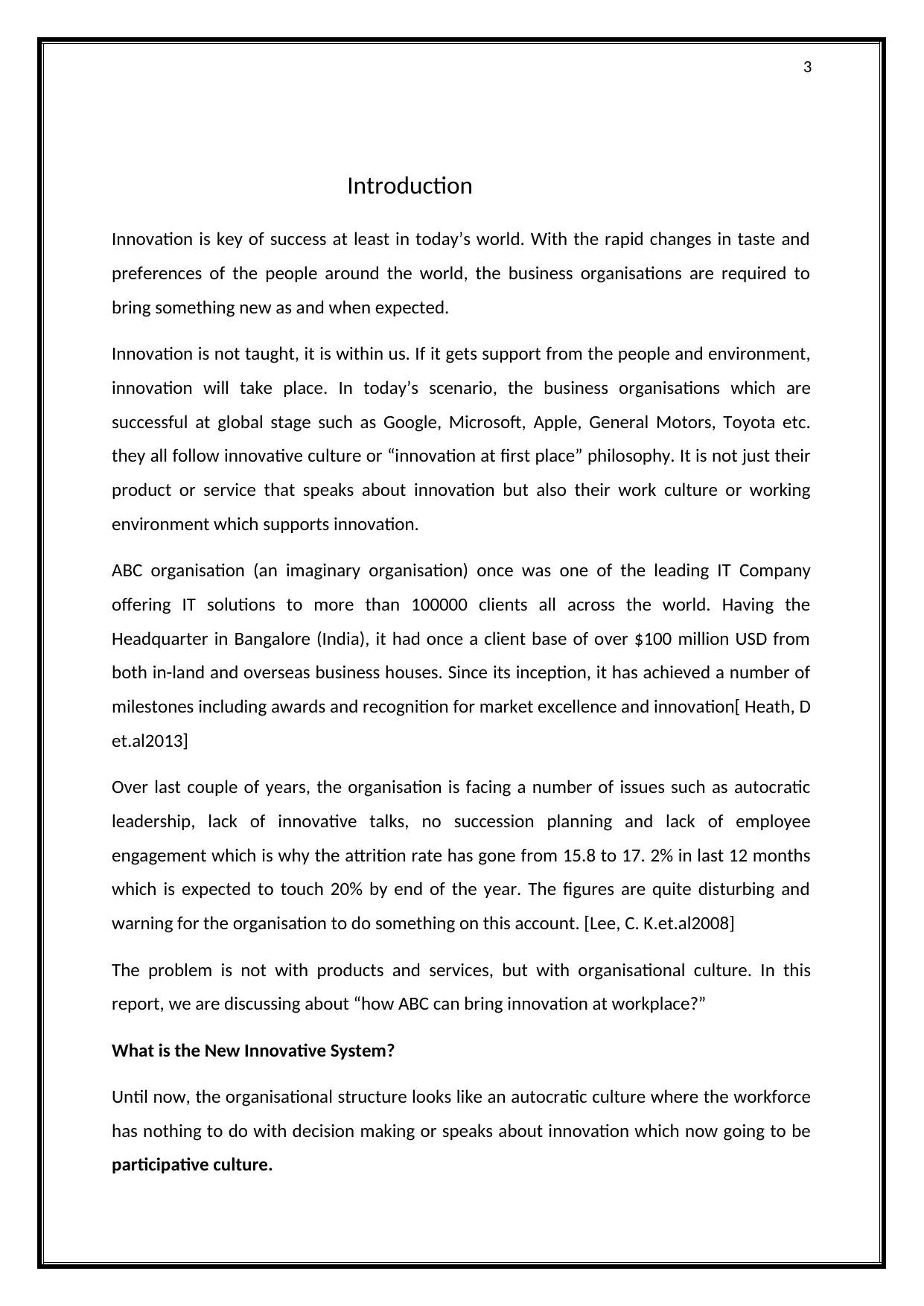
3
Introduction
Innovation is key of success at least in today’s world. With the rapid changes in taste and
preferences of the people around the world, the business organisations are required to
bring something new as and when expected.
Innovation is not taught, it is within us. If it gets support from the people and environment,
innovation will take place. In today’s scenario, the business organisations which are
successful at global stage such as Google, Microsoft, Apple, General Motors, Toyota etc.
they all follow innovative culture or “innovation at first place” philosophy. It is not just their
product or service that speaks about innovation but also their work culture or working
environment which supports innovation.
ABC organisation (an imaginary organisation) once was one of the leading IT Company
offering IT solutions to more than 100000 clients all across the world. Having the
Headquarter in Bangalore (India), it had once a client base of over $100 million USD from
both in-land and overseas business houses. Since its inception, it has achieved a number of
milestones including awards and recognition for market excellence and innovation[ Heath, D
et.al2013]
Over last couple of years, the organisation is facing a number of issues such as autocratic
leadership, lack of innovative talks, no succession planning and lack of employee
engagement which is why the attrition rate has gone from 15.8 to 17. 2% in last 12 months
which is expected to touch 20% by end of the year. The figures are quite disturbing and
warning for the organisation to do something on this account. [Lee, C. K.et.al2008]
The problem is not with products and services, but with organisational culture. In this
report, we are discussing about “how ABC can bring innovation at workplace?”
What is the New Innovative System?
Until now, the organisational structure looks like an autocratic culture where the workforce
has nothing to do with decision making or speaks about innovation which now going to be
participative culture.
Introduction
Innovation is key of success at least in today’s world. With the rapid changes in taste and
preferences of the people around the world, the business organisations are required to
bring something new as and when expected.
Innovation is not taught, it is within us. If it gets support from the people and environment,
innovation will take place. In today’s scenario, the business organisations which are
successful at global stage such as Google, Microsoft, Apple, General Motors, Toyota etc.
they all follow innovative culture or “innovation at first place” philosophy. It is not just their
product or service that speaks about innovation but also their work culture or working
environment which supports innovation.
ABC organisation (an imaginary organisation) once was one of the leading IT Company
offering IT solutions to more than 100000 clients all across the world. Having the
Headquarter in Bangalore (India), it had once a client base of over $100 million USD from
both in-land and overseas business houses. Since its inception, it has achieved a number of
milestones including awards and recognition for market excellence and innovation[ Heath, D
et.al2013]
Over last couple of years, the organisation is facing a number of issues such as autocratic
leadership, lack of innovative talks, no succession planning and lack of employee
engagement which is why the attrition rate has gone from 15.8 to 17. 2% in last 12 months
which is expected to touch 20% by end of the year. The figures are quite disturbing and
warning for the organisation to do something on this account. [Lee, C. K.et.al2008]
The problem is not with products and services, but with organisational culture. In this
report, we are discussing about “how ABC can bring innovation at workplace?”
What is the New Innovative System?
Until now, the organisational structure looks like an autocratic culture where the workforce
has nothing to do with decision making or speaks about innovation which now going to be
participative culture.
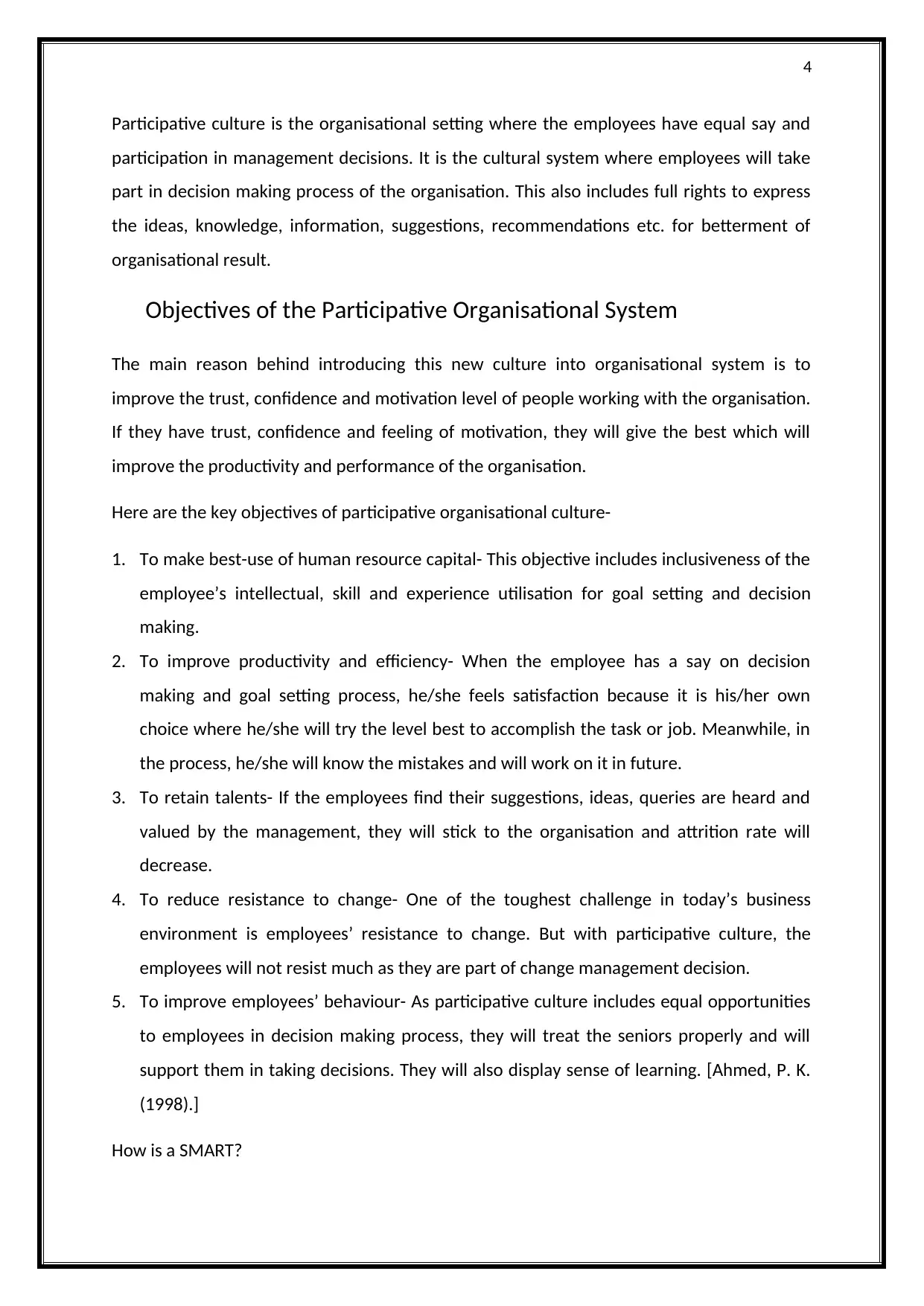
4
Participative culture is the organisational setting where the employees have equal say and
participation in management decisions. It is the cultural system where employees will take
part in decision making process of the organisation. This also includes full rights to express
the ideas, knowledge, information, suggestions, recommendations etc. for betterment of
organisational result.
Objectives of the Participative Organisational System
The main reason behind introducing this new culture into organisational system is to
improve the trust, confidence and motivation level of people working with the organisation.
If they have trust, confidence and feeling of motivation, they will give the best which will
improve the productivity and performance of the organisation.
Here are the key objectives of participative organisational culture-
1. To make best-use of human resource capital- This objective includes inclusiveness of the
employee’s intellectual, skill and experience utilisation for goal setting and decision
making.
2. To improve productivity and efficiency- When the employee has a say on decision
making and goal setting process, he/she feels satisfaction because it is his/her own
choice where he/she will try the level best to accomplish the task or job. Meanwhile, in
the process, he/she will know the mistakes and will work on it in future.
3. To retain talents- If the employees find their suggestions, ideas, queries are heard and
valued by the management, they will stick to the organisation and attrition rate will
decrease.
4. To reduce resistance to change- One of the toughest challenge in today’s business
environment is employees’ resistance to change. But with participative culture, the
employees will not resist much as they are part of change management decision.
5. To improve employees’ behaviour- As participative culture includes equal opportunities
to employees in decision making process, they will treat the seniors properly and will
support them in taking decisions. They will also display sense of learning. [Ahmed, P. K.
(1998).]
How is a SMART?
Participative culture is the organisational setting where the employees have equal say and
participation in management decisions. It is the cultural system where employees will take
part in decision making process of the organisation. This also includes full rights to express
the ideas, knowledge, information, suggestions, recommendations etc. for betterment of
organisational result.
Objectives of the Participative Organisational System
The main reason behind introducing this new culture into organisational system is to
improve the trust, confidence and motivation level of people working with the organisation.
If they have trust, confidence and feeling of motivation, they will give the best which will
improve the productivity and performance of the organisation.
Here are the key objectives of participative organisational culture-
1. To make best-use of human resource capital- This objective includes inclusiveness of the
employee’s intellectual, skill and experience utilisation for goal setting and decision
making.
2. To improve productivity and efficiency- When the employee has a say on decision
making and goal setting process, he/she feels satisfaction because it is his/her own
choice where he/she will try the level best to accomplish the task or job. Meanwhile, in
the process, he/she will know the mistakes and will work on it in future.
3. To retain talents- If the employees find their suggestions, ideas, queries are heard and
valued by the management, they will stick to the organisation and attrition rate will
decrease.
4. To reduce resistance to change- One of the toughest challenge in today’s business
environment is employees’ resistance to change. But with participative culture, the
employees will not resist much as they are part of change management decision.
5. To improve employees’ behaviour- As participative culture includes equal opportunities
to employees in decision making process, they will treat the seniors properly and will
support them in taking decisions. They will also display sense of learning. [Ahmed, P. K.
(1998).]
How is a SMART?
Secure Best Marks with AI Grader
Need help grading? Try our AI Grader for instant feedback on your assignments.

5
Simple or Specific- Participative culture aims at employee engagement and contribution
towards organisational success.
Measureable- After introduction of participative culture, the success can be measured from
the key indicators such as productivity rate, revenue growth, attrition rate and overall
growth rate.
Assignable- Participative culture will be introduced into structure with a joint effort of
management and employees.
Realistic- This cultural introduction is realistic because empirical evidences show
improvement in performance if employees feel engaged.
Time-Bound- Full implementation of this culture will take 1 year at best.
Impact Assessment of the new system
The impact of the new cultural system will the following impact on employees, departments
(teams) and organisation as a whole. [Martins, E. C. et.al2003]
Impact on Employees
1. It brings motivation and feeling of being engaged with the organisation. As the
employee’s voice is counted, he/she tries to come up with more ideas and suggestions.
2. It brings higher productivity as the employee is able to understand the roles,
responsibility and expectations for the work.
3. It increases the efficiency and effectiveness of workforce as participative environment
creates a learning environment for the employees.
4. When employees feel their importance in the organisation, they show a positive
behaviour on his/her work and show respect to seniors. This also results in less
absenteeism and low employee turnover.
5. Employees show a greater support in organisational change.
6. Participative culture brings people closer to each other in the organisation which helps
in establishing healthy communication system among them.
7. Employees bring their innovative ideas, skills and experience into practice for better
results.
Simple or Specific- Participative culture aims at employee engagement and contribution
towards organisational success.
Measureable- After introduction of participative culture, the success can be measured from
the key indicators such as productivity rate, revenue growth, attrition rate and overall
growth rate.
Assignable- Participative culture will be introduced into structure with a joint effort of
management and employees.
Realistic- This cultural introduction is realistic because empirical evidences show
improvement in performance if employees feel engaged.
Time-Bound- Full implementation of this culture will take 1 year at best.
Impact Assessment of the new system
The impact of the new cultural system will the following impact on employees, departments
(teams) and organisation as a whole. [Martins, E. C. et.al2003]
Impact on Employees
1. It brings motivation and feeling of being engaged with the organisation. As the
employee’s voice is counted, he/she tries to come up with more ideas and suggestions.
2. It brings higher productivity as the employee is able to understand the roles,
responsibility and expectations for the work.
3. It increases the efficiency and effectiveness of workforce as participative environment
creates a learning environment for the employees.
4. When employees feel their importance in the organisation, they show a positive
behaviour on his/her work and show respect to seniors. This also results in less
absenteeism and low employee turnover.
5. Employees show a greater support in organisational change.
6. Participative culture brings people closer to each other in the organisation which helps
in establishing healthy communication system among them.
7. Employees bring their innovative ideas, skills and experience into practice for better
results.
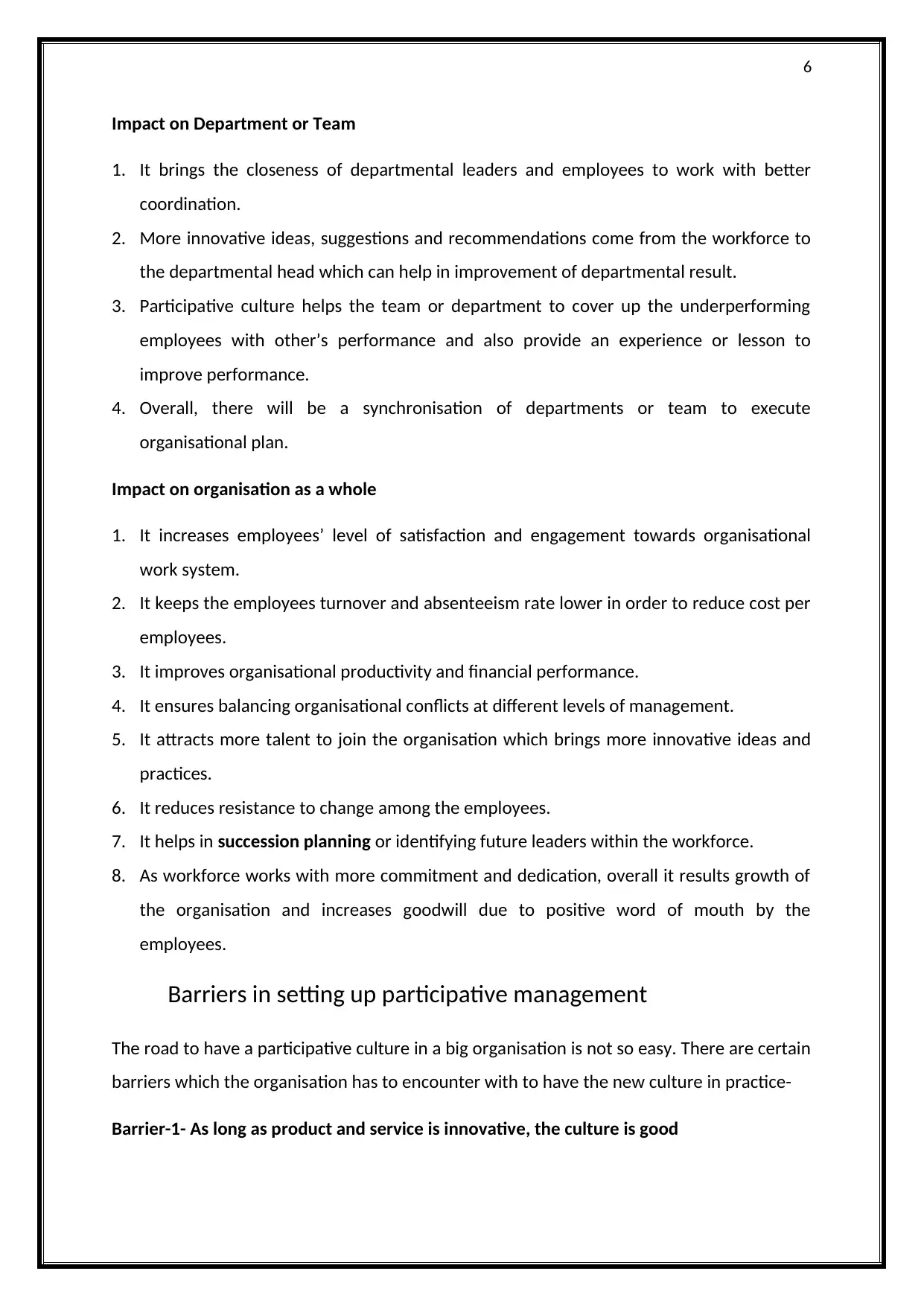
6
Impact on Department or Team
1. It brings the closeness of departmental leaders and employees to work with better
coordination.
2. More innovative ideas, suggestions and recommendations come from the workforce to
the departmental head which can help in improvement of departmental result.
3. Participative culture helps the team or department to cover up the underperforming
employees with other’s performance and also provide an experience or lesson to
improve performance.
4. Overall, there will be a synchronisation of departments or team to execute
organisational plan.
Impact on organisation as a whole
1. It increases employees’ level of satisfaction and engagement towards organisational
work system.
2. It keeps the employees turnover and absenteeism rate lower in order to reduce cost per
employees.
3. It improves organisational productivity and financial performance.
4. It ensures balancing organisational conflicts at different levels of management.
5. It attracts more talent to join the organisation which brings more innovative ideas and
practices.
6. It reduces resistance to change among the employees.
7. It helps in succession planning or identifying future leaders within the workforce.
8. As workforce works with more commitment and dedication, overall it results growth of
the organisation and increases goodwill due to positive word of mouth by the
employees.
Barriers in setting up participative management
The road to have a participative culture in a big organisation is not so easy. There are certain
barriers which the organisation has to encounter with to have the new culture in practice-
Barrier-1- As long as product and service is innovative, the culture is good
Impact on Department or Team
1. It brings the closeness of departmental leaders and employees to work with better
coordination.
2. More innovative ideas, suggestions and recommendations come from the workforce to
the departmental head which can help in improvement of departmental result.
3. Participative culture helps the team or department to cover up the underperforming
employees with other’s performance and also provide an experience or lesson to
improve performance.
4. Overall, there will be a synchronisation of departments or team to execute
organisational plan.
Impact on organisation as a whole
1. It increases employees’ level of satisfaction and engagement towards organisational
work system.
2. It keeps the employees turnover and absenteeism rate lower in order to reduce cost per
employees.
3. It improves organisational productivity and financial performance.
4. It ensures balancing organisational conflicts at different levels of management.
5. It attracts more talent to join the organisation which brings more innovative ideas and
practices.
6. It reduces resistance to change among the employees.
7. It helps in succession planning or identifying future leaders within the workforce.
8. As workforce works with more commitment and dedication, overall it results growth of
the organisation and increases goodwill due to positive word of mouth by the
employees.
Barriers in setting up participative management
The road to have a participative culture in a big organisation is not so easy. There are certain
barriers which the organisation has to encounter with to have the new culture in practice-
Barrier-1- As long as product and service is innovative, the culture is good
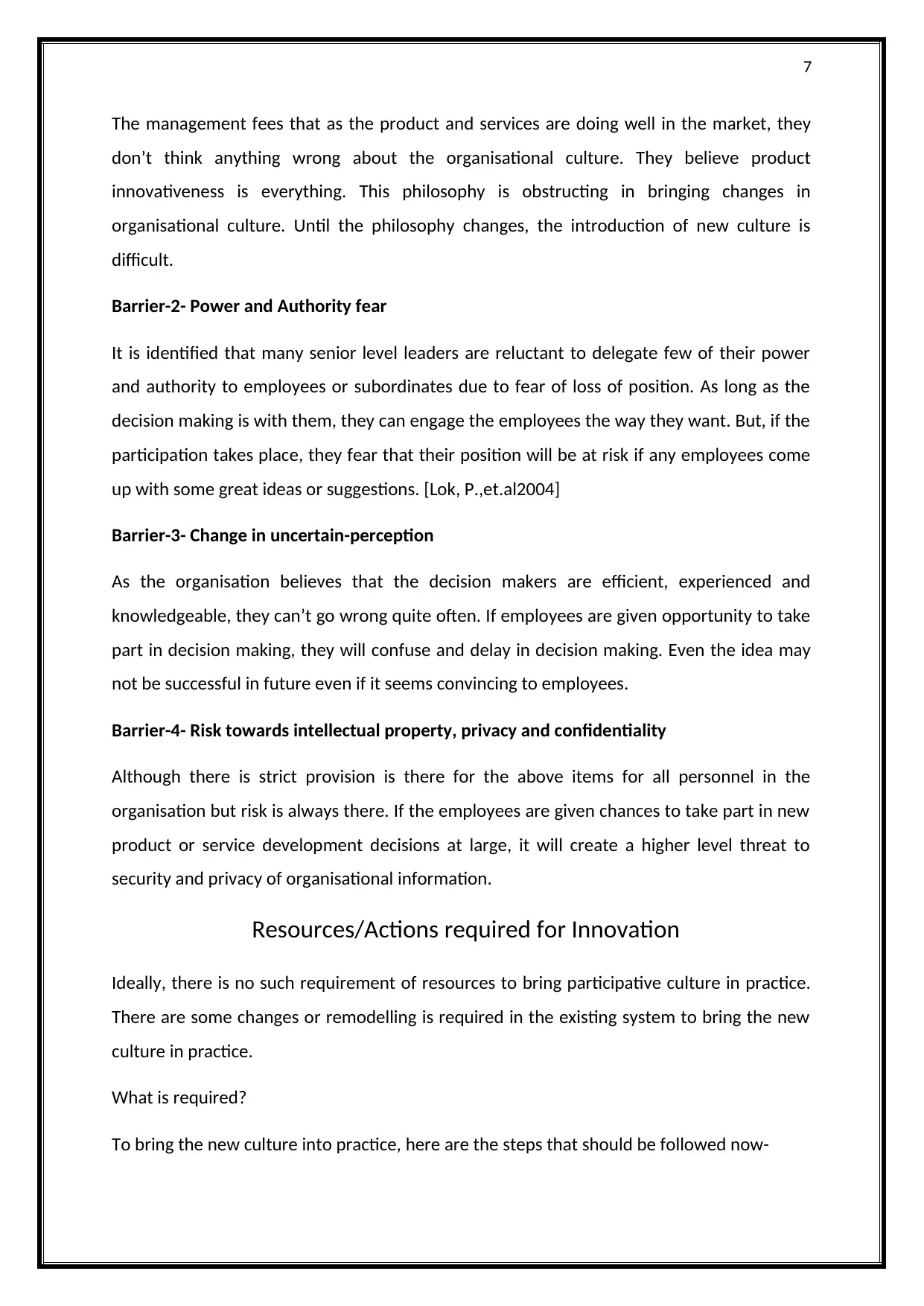
7
The management fees that as the product and services are doing well in the market, they
don’t think anything wrong about the organisational culture. They believe product
innovativeness is everything. This philosophy is obstructing in bringing changes in
organisational culture. Until the philosophy changes, the introduction of new culture is
difficult.
Barrier-2- Power and Authority fear
It is identified that many senior level leaders are reluctant to delegate few of their power
and authority to employees or subordinates due to fear of loss of position. As long as the
decision making is with them, they can engage the employees the way they want. But, if the
participation takes place, they fear that their position will be at risk if any employees come
up with some great ideas or suggestions. [Lok, P.,et.al2004]
Barrier-3- Change in uncertain-perception
As the organisation believes that the decision makers are efficient, experienced and
knowledgeable, they can’t go wrong quite often. If employees are given opportunity to take
part in decision making, they will confuse and delay in decision making. Even the idea may
not be successful in future even if it seems convincing to employees.
Barrier-4- Risk towards intellectual property, privacy and confidentiality
Although there is strict provision is there for the above items for all personnel in the
organisation but risk is always there. If the employees are given chances to take part in new
product or service development decisions at large, it will create a higher level threat to
security and privacy of organisational information.
Resources/Actions required for Innovation
Ideally, there is no such requirement of resources to bring participative culture in practice.
There are some changes or remodelling is required in the existing system to bring the new
culture in practice.
What is required?
To bring the new culture into practice, here are the steps that should be followed now-
The management fees that as the product and services are doing well in the market, they
don’t think anything wrong about the organisational culture. They believe product
innovativeness is everything. This philosophy is obstructing in bringing changes in
organisational culture. Until the philosophy changes, the introduction of new culture is
difficult.
Barrier-2- Power and Authority fear
It is identified that many senior level leaders are reluctant to delegate few of their power
and authority to employees or subordinates due to fear of loss of position. As long as the
decision making is with them, they can engage the employees the way they want. But, if the
participation takes place, they fear that their position will be at risk if any employees come
up with some great ideas or suggestions. [Lok, P.,et.al2004]
Barrier-3- Change in uncertain-perception
As the organisation believes that the decision makers are efficient, experienced and
knowledgeable, they can’t go wrong quite often. If employees are given opportunity to take
part in decision making, they will confuse and delay in decision making. Even the idea may
not be successful in future even if it seems convincing to employees.
Barrier-4- Risk towards intellectual property, privacy and confidentiality
Although there is strict provision is there for the above items for all personnel in the
organisation but risk is always there. If the employees are given chances to take part in new
product or service development decisions at large, it will create a higher level threat to
security and privacy of organisational information.
Resources/Actions required for Innovation
Ideally, there is no such requirement of resources to bring participative culture in practice.
There are some changes or remodelling is required in the existing system to bring the new
culture in practice.
What is required?
To bring the new culture into practice, here are the steps that should be followed now-
Paraphrase This Document
Need a fresh take? Get an instant paraphrase of this document with our AI Paraphraser
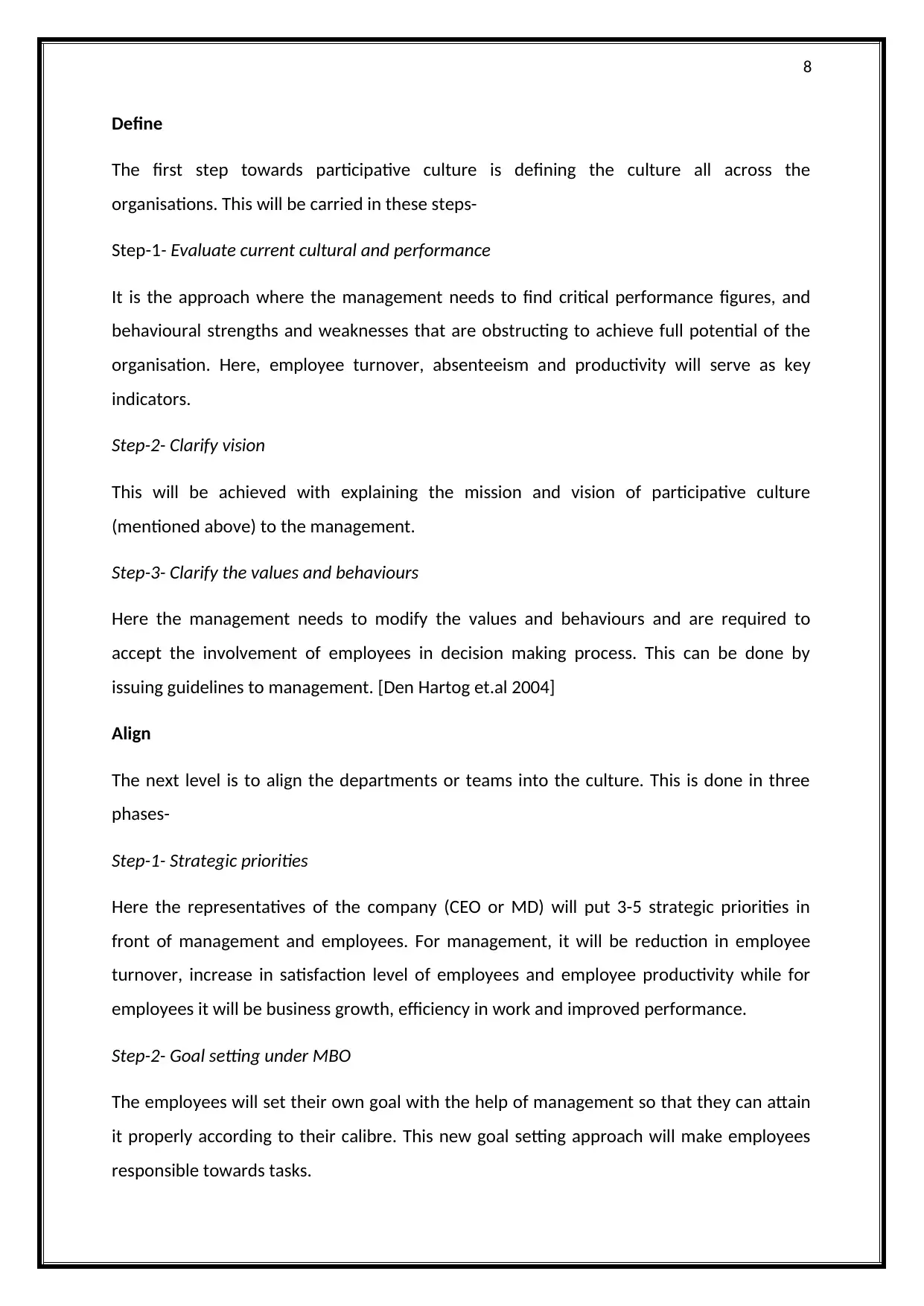
8
Define
The first step towards participative culture is defining the culture all across the
organisations. This will be carried in these steps-
Step-1- Evaluate current cultural and performance
It is the approach where the management needs to find critical performance figures, and
behavioural strengths and weaknesses that are obstructing to achieve full potential of the
organisation. Here, employee turnover, absenteeism and productivity will serve as key
indicators.
Step-2- Clarify vision
This will be achieved with explaining the mission and vision of participative culture
(mentioned above) to the management.
Step-3- Clarify the values and behaviours
Here the management needs to modify the values and behaviours and are required to
accept the involvement of employees in decision making process. This can be done by
issuing guidelines to management. [Den Hartog et.al 2004]
Align
The next level is to align the departments or teams into the culture. This is done in three
phases-
Step-1- Strategic priorities
Here the representatives of the company (CEO or MD) will put 3-5 strategic priorities in
front of management and employees. For management, it will be reduction in employee
turnover, increase in satisfaction level of employees and employee productivity while for
employees it will be business growth, efficiency in work and improved performance.
Step-2- Goal setting under MBO
The employees will set their own goal with the help of management so that they can attain
it properly according to their calibre. This new goal setting approach will make employees
responsible towards tasks.
Define
The first step towards participative culture is defining the culture all across the
organisations. This will be carried in these steps-
Step-1- Evaluate current cultural and performance
It is the approach where the management needs to find critical performance figures, and
behavioural strengths and weaknesses that are obstructing to achieve full potential of the
organisation. Here, employee turnover, absenteeism and productivity will serve as key
indicators.
Step-2- Clarify vision
This will be achieved with explaining the mission and vision of participative culture
(mentioned above) to the management.
Step-3- Clarify the values and behaviours
Here the management needs to modify the values and behaviours and are required to
accept the involvement of employees in decision making process. This can be done by
issuing guidelines to management. [Den Hartog et.al 2004]
Align
The next level is to align the departments or teams into the culture. This is done in three
phases-
Step-1- Strategic priorities
Here the representatives of the company (CEO or MD) will put 3-5 strategic priorities in
front of management and employees. For management, it will be reduction in employee
turnover, increase in satisfaction level of employees and employee productivity while for
employees it will be business growth, efficiency in work and improved performance.
Step-2- Goal setting under MBO
The employees will set their own goal with the help of management so that they can attain
it properly according to their calibre. This new goal setting approach will make employees
responsible towards tasks.

9
Step-3- Clarify and track key measures
This is the same phase that is followed in define one. Here the management will carry a
review on the key indicators discussed above after introduction of the new culture. It will
reveal the positive or negative impact of the innovative step. [Van der Post, W. Z.,et.al1998]
Manage
Innovation is continues approach that should continue thus once the organisation
introduced the new culture, it needs to retain it. This is done in the following way-
Step-1- Review of culture
It is the approach where the top level management will oversee the organisational
functioning under participative culture. Here the review includes the no. of decisions that
are taken jointly in the organisation.
Step-2- Review of employees’ performance in relation to organisational performance
Here the management will review employees’ performance and its effect on organisational
performance.
Step-3- Building motivation and involvement throughout the process
In the innovative culture i.e. collaborative decision making culture, the management will
seek feedbacks and suggestions in regular interval (may be weekly, bi-weekly or monthly) so
that employees will feel motivated and will involve themselves more towards organisational
success. This includes activities such as brainstorming, simulation or role play and other
management games. [Day, D. V et.al 2012]
Stakeholder’s engagement in the innovative culture process
Stakeholder Role towards innovative culture
MD and CEO He is expected to be the change agent for
the organisation who will speak out the
new cultural system to management and
employees. He and the board will set
guidelines for the change after taking
Step-3- Clarify and track key measures
This is the same phase that is followed in define one. Here the management will carry a
review on the key indicators discussed above after introduction of the new culture. It will
reveal the positive or negative impact of the innovative step. [Van der Post, W. Z.,et.al1998]
Manage
Innovation is continues approach that should continue thus once the organisation
introduced the new culture, it needs to retain it. This is done in the following way-
Step-1- Review of culture
It is the approach where the top level management will oversee the organisational
functioning under participative culture. Here the review includes the no. of decisions that
are taken jointly in the organisation.
Step-2- Review of employees’ performance in relation to organisational performance
Here the management will review employees’ performance and its effect on organisational
performance.
Step-3- Building motivation and involvement throughout the process
In the innovative culture i.e. collaborative decision making culture, the management will
seek feedbacks and suggestions in regular interval (may be weekly, bi-weekly or monthly) so
that employees will feel motivated and will involve themselves more towards organisational
success. This includes activities such as brainstorming, simulation or role play and other
management games. [Day, D. V et.al 2012]
Stakeholder’s engagement in the innovative culture process
Stakeholder Role towards innovative culture
MD and CEO He is expected to be the change agent for
the organisation who will speak out the
new cultural system to management and
employees. He and the board will set
guidelines for the change after taking

10
necessary feedbacks from the two levels.
Board of Directors They will set the guidelines or framework
for the collaborative decision making
culture. They will set the roles, authorities
and responsibilities of each parties
(management and employees) while
decision making is going on.
Management (Departmental Head) They will carry the framework to the
employees and will engage employees for
any departmental decisions whether it is of
smaller or larger scale. They will also
promote joint decision (the plan or activity
that majority favours) to implement.
Employees They will take part in decision making by
bringing their ideas, knowledge, skill and
experience into practice. They will also take
the responsibilities and accountability for
the said actions suggested.
Human Resource The HR manager will establish coordination
between employees and management
through employee engagement programs.
Trade Union To promote and encourage collaborative
decision making culture among younger
employees.
[Bourne, L. (2016)]
What if no actions taken?
There can be two options that are applicable to in this situation. The first option is “Do
nothing and let it go as it is’ or “bring participative decision making into practice.”
If Do nothing-
necessary feedbacks from the two levels.
Board of Directors They will set the guidelines or framework
for the collaborative decision making
culture. They will set the roles, authorities
and responsibilities of each parties
(management and employees) while
decision making is going on.
Management (Departmental Head) They will carry the framework to the
employees and will engage employees for
any departmental decisions whether it is of
smaller or larger scale. They will also
promote joint decision (the plan or activity
that majority favours) to implement.
Employees They will take part in decision making by
bringing their ideas, knowledge, skill and
experience into practice. They will also take
the responsibilities and accountability for
the said actions suggested.
Human Resource The HR manager will establish coordination
between employees and management
through employee engagement programs.
Trade Union To promote and encourage collaborative
decision making culture among younger
employees.
[Bourne, L. (2016)]
What if no actions taken?
There can be two options that are applicable to in this situation. The first option is “Do
nothing and let it go as it is’ or “bring participative decision making into practice.”
If Do nothing-
Secure Best Marks with AI Grader
Need help grading? Try our AI Grader for instant feedback on your assignments.
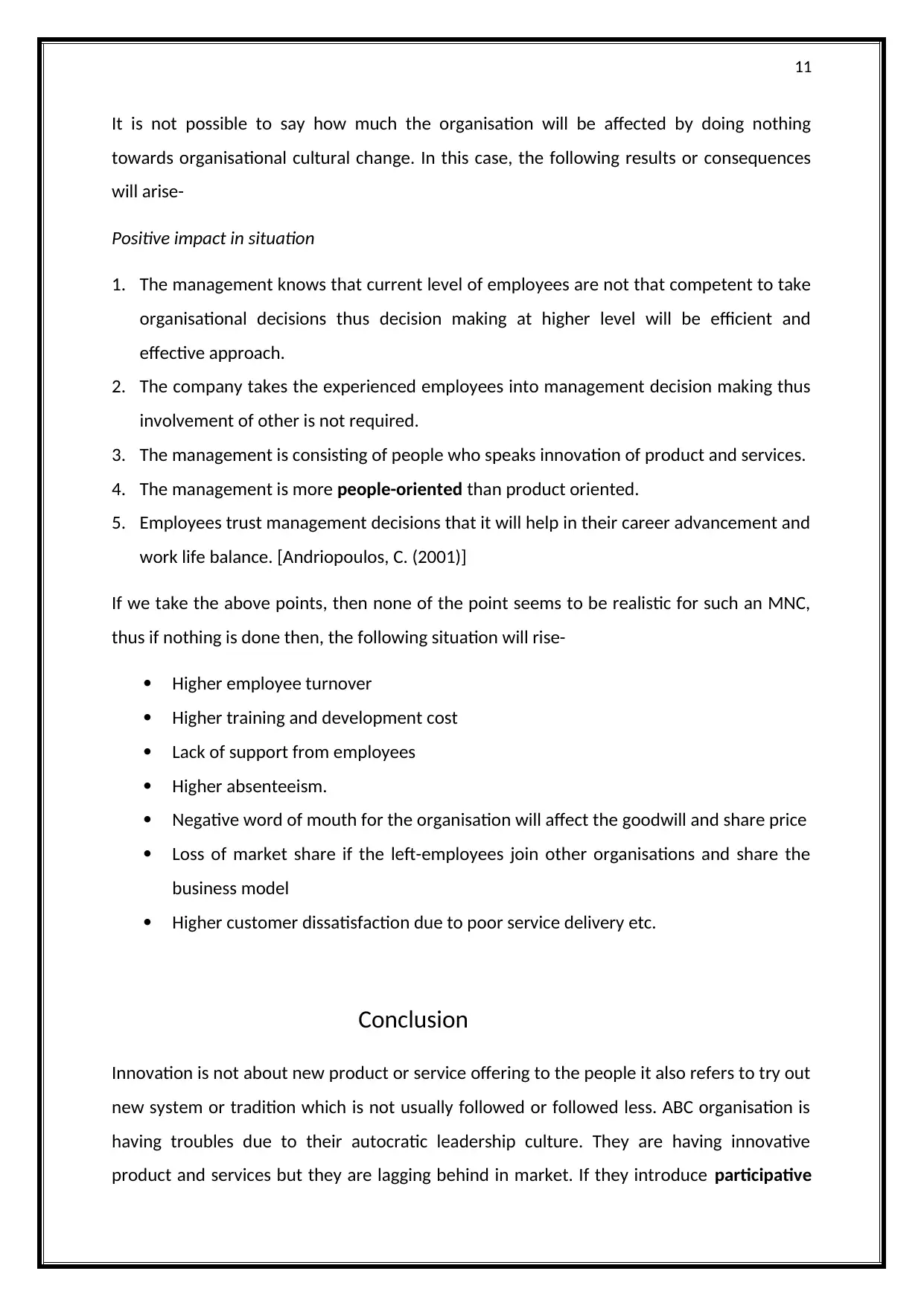
11
It is not possible to say how much the organisation will be affected by doing nothing
towards organisational cultural change. In this case, the following results or consequences
will arise-
Positive impact in situation
1. The management knows that current level of employees are not that competent to take
organisational decisions thus decision making at higher level will be efficient and
effective approach.
2. The company takes the experienced employees into management decision making thus
involvement of other is not required.
3. The management is consisting of people who speaks innovation of product and services.
4. The management is more people-oriented than product oriented.
5. Employees trust management decisions that it will help in their career advancement and
work life balance. [Andriopoulos, C. (2001)]
If we take the above points, then none of the point seems to be realistic for such an MNC,
thus if nothing is done then, the following situation will rise-
Higher employee turnover
Higher training and development cost
Lack of support from employees
Higher absenteeism.
Negative word of mouth for the organisation will affect the goodwill and share price
Loss of market share if the left-employees join other organisations and share the
business model
Higher customer dissatisfaction due to poor service delivery etc.
Conclusion
Innovation is not about new product or service offering to the people it also refers to try out
new system or tradition which is not usually followed or followed less. ABC organisation is
having troubles due to their autocratic leadership culture. They are having innovative
product and services but they are lagging behind in market. If they introduce participative
It is not possible to say how much the organisation will be affected by doing nothing
towards organisational cultural change. In this case, the following results or consequences
will arise-
Positive impact in situation
1. The management knows that current level of employees are not that competent to take
organisational decisions thus decision making at higher level will be efficient and
effective approach.
2. The company takes the experienced employees into management decision making thus
involvement of other is not required.
3. The management is consisting of people who speaks innovation of product and services.
4. The management is more people-oriented than product oriented.
5. Employees trust management decisions that it will help in their career advancement and
work life balance. [Andriopoulos, C. (2001)]
If we take the above points, then none of the point seems to be realistic for such an MNC,
thus if nothing is done then, the following situation will rise-
Higher employee turnover
Higher training and development cost
Lack of support from employees
Higher absenteeism.
Negative word of mouth for the organisation will affect the goodwill and share price
Loss of market share if the left-employees join other organisations and share the
business model
Higher customer dissatisfaction due to poor service delivery etc.
Conclusion
Innovation is not about new product or service offering to the people it also refers to try out
new system or tradition which is not usually followed or followed less. ABC organisation is
having troubles due to their autocratic leadership culture. They are having innovative
product and services but they are lagging behind in market. If they introduce participative
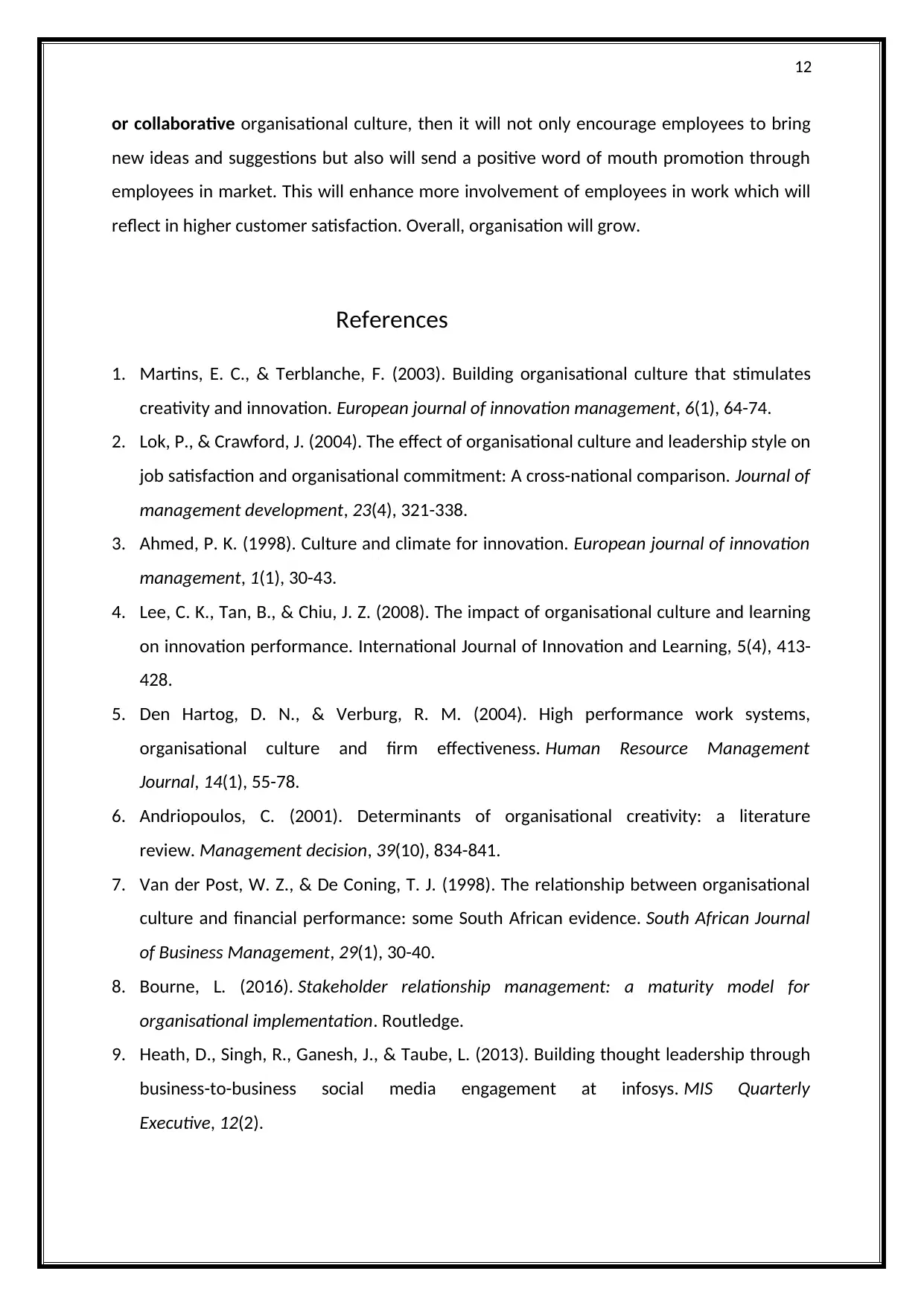
12
or collaborative organisational culture, then it will not only encourage employees to bring
new ideas and suggestions but also will send a positive word of mouth promotion through
employees in market. This will enhance more involvement of employees in work which will
reflect in higher customer satisfaction. Overall, organisation will grow.
References
1. Martins, E. C., & Terblanche, F. (2003). Building organisational culture that stimulates
creativity and innovation. European journal of innovation management, 6(1), 64-74.
2. Lok, P., & Crawford, J. (2004). The effect of organisational culture and leadership style on
job satisfaction and organisational commitment: A cross-national comparison. Journal of
management development, 23(4), 321-338.
3. Ahmed, P. K. (1998). Culture and climate for innovation. European journal of innovation
management, 1(1), 30-43.
4. Lee, C. K., Tan, B., & Chiu, J. Z. (2008). The impact of organisational culture and learning
on innovation performance. International Journal of Innovation and Learning, 5(4), 413-
428.
5. Den Hartog, D. N., & Verburg, R. M. (2004). High performance work systems,
organisational culture and firm effectiveness. Human Resource Management
Journal, 14(1), 55-78.
6. Andriopoulos, C. (2001). Determinants of organisational creativity: a literature
review. Management decision, 39(10), 834-841.
7. Van der Post, W. Z., & De Coning, T. J. (1998). The relationship between organisational
culture and financial performance: some South African evidence. South African Journal
of Business Management, 29(1), 30-40.
8. Bourne, L. (2016). Stakeholder relationship management: a maturity model for
organisational implementation. Routledge.
9. Heath, D., Singh, R., Ganesh, J., & Taube, L. (2013). Building thought leadership through
business-to-business social media engagement at infosys. MIS Quarterly
Executive, 12(2).
or collaborative organisational culture, then it will not only encourage employees to bring
new ideas and suggestions but also will send a positive word of mouth promotion through
employees in market. This will enhance more involvement of employees in work which will
reflect in higher customer satisfaction. Overall, organisation will grow.
References
1. Martins, E. C., & Terblanche, F. (2003). Building organisational culture that stimulates
creativity and innovation. European journal of innovation management, 6(1), 64-74.
2. Lok, P., & Crawford, J. (2004). The effect of organisational culture and leadership style on
job satisfaction and organisational commitment: A cross-national comparison. Journal of
management development, 23(4), 321-338.
3. Ahmed, P. K. (1998). Culture and climate for innovation. European journal of innovation
management, 1(1), 30-43.
4. Lee, C. K., Tan, B., & Chiu, J. Z. (2008). The impact of organisational culture and learning
on innovation performance. International Journal of Innovation and Learning, 5(4), 413-
428.
5. Den Hartog, D. N., & Verburg, R. M. (2004). High performance work systems,
organisational culture and firm effectiveness. Human Resource Management
Journal, 14(1), 55-78.
6. Andriopoulos, C. (2001). Determinants of organisational creativity: a literature
review. Management decision, 39(10), 834-841.
7. Van der Post, W. Z., & De Coning, T. J. (1998). The relationship between organisational
culture and financial performance: some South African evidence. South African Journal
of Business Management, 29(1), 30-40.
8. Bourne, L. (2016). Stakeholder relationship management: a maturity model for
organisational implementation. Routledge.
9. Heath, D., Singh, R., Ganesh, J., & Taube, L. (2013). Building thought leadership through
business-to-business social media engagement at infosys. MIS Quarterly
Executive, 12(2).
1 out of 12
Related Documents
Your All-in-One AI-Powered Toolkit for Academic Success.
+13062052269
info@desklib.com
Available 24*7 on WhatsApp / Email
![[object Object]](/_next/static/media/star-bottom.7253800d.svg)
Unlock your academic potential
© 2024 | Zucol Services PVT LTD | All rights reserved.





